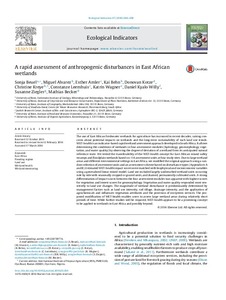| dc.contributor.author | Beuel, S. |
| dc.contributor.author | Álvarez, M. |
| dc.contributor.author | Amler, E. |
| dc.contributor.author | Behn, K. |
| dc.contributor.author | Kotze, D. |
| dc.contributor.author | Kreye, C. |
| dc.contributor.author | Leemhuis, C. |
| dc.contributor.author | Wagner, K. |
| dc.contributor.author | Willy, D.K. |
| dc.contributor.author | Ziegler, S. |
| dc.contributor.author | Becker, M. |
| dc.date.accessioned | 2019-12-04T11:04:28Z |
| dc.date.available | 2019-12-04T11:04:28Z |
| dc.date.issued | 2016-08 |
| dc.identifier.citation | Beuel, S., Alvarez, M., Amler, E., Behn, K., Kotze, D., Kreye, C., ... & Becker, M. (2016). A rapid assessment of anthropogenic disturbances in East African wetlands. Ecological Indicators, 67, 684-692. |
| dc.identifier.issn | 1470-160X |
| dc.identifier.uri | https://hdl.handle.net/20.500.12478/1436 |
| dc.description | Published online: 25 April 2016 |
| dc.description.abstract | The use of East African freshwater wetlands for agriculture has increased in recent decades, raising concerns about potential impacts on wetlands and the long-term sustainability of such land use trends. WET-health is an indicator-based rapid wetland assessment approach developed in South Africa. It allows determining the conditions of wetlands in four assessment modules (hydrology, geomorphology, vegetation, and water quality) by observing the degree of deviation of a wetland from its anticipated natural reference state. We tested the transferability of the WET-health concept for East African inland valley swamps and floodplain wetlands based on 114 assessment units at four study sites. Due to large wetland areas and different environmental settings in East Africa, we modified the original approach using a random selection of assessment units and an assessment scheme based on disturbance types (Appendices A and B). Estimated WET-health impact scores were matched with biophysical and socioeconomic variables using a generalized linear mixed model. Land use included largely undisturbed wetland units occurring side by side with seasonally cropped or grazed units, and drained, permanently cultivated units. A strong differentiation of impact scores between the four assessment modules was apparent with highest scores for vegetation and lowest scores for geomorphology. Vegetation and water quality responded most sensitively to land use changes. The magnitude of wetland disturbance is predominantly determined by management factors such as land use intensity, soil tillage, drainage intensity, and the application of agrochemicals and influences vegetation attributes and the provision of ecosystem services. The proposed modification of WET-health enables users to assess large wetland areas during relatively short periods of time. While further studies will be required, WET-health appears to be a promising concept to be applied to wetlands in East Africa and possibly beyond. |
| dc.format.extent | 684-692 |
| dc.language.iso | en |
| dc.subject | Land Use |
| dc.subject | Climate Change |
| dc.subject | Food Production |
| dc.subject | Wetlands |
| dc.subject | Anthropogenic |
| dc.title | A rapid assessment of anthropogenic disturbances in East African wetlands |
| dc.type | Journal Article |
| dc.description.version | Peer Review |
| cg.contributor.crp | Water, Land and Ecosystems |
| cg.contributor.affiliation | University of Bonn |
| cg.contributor.affiliation | University of KwaZulu-Natal |
| cg.contributor.affiliation | International Institute of Tropical Agriculture |
| cg.contributor.affiliation | Juelich Research Center, Germany |
| cg.coverage.region | Africa |
| cg.coverage.region | East Africa |
| cg.coverage.country | Kenya |
| cg.coverage.country | Rwanda |
| cg.coverage.country | Tanzania |
| cg.coverage.country | Uganda |
| cg.isijournal | ISI Journal |
| cg.authorship.types | CGIAR and developing country institute |
| cg.journal | Ecological Indicators |
| cg.howpublished | Formally Published |
| cg.accessibilitystatus | Limited Access |
| local.dspaceid | 79710 |
| cg.targetaudience | Scientists |
| cg.identifier.doi | https://dx.doi.org/10.1016/j.ecolind.2016.03.034 |

